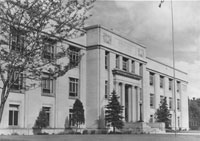Summary 2011 WY 42
Summary of Decision March 9, 2011
[SPECIAL NOTE: This opinion uses the "Universal Citation." It was given an "official" citation when it is issued. You should use this citation whenever you cite the opinion, with a P.3d parallel citation. You will also note when you look at the opinion that all of the paragraphs are numbered. When you need to provide a pinpoint citation to a quote the universal portion of the citation will use that paragraph number. The pinpoint citation in the P.3d portion will need to have the reporter page number. If you need assistance in putting together a citation from this, or any future opinion using the Universal Citation form, please contact the Wyoming State Law Library and we will provide any needed assistance]
Summaries are prepared by Law Librarians and are not official statements of the Wyoming Supreme Court
Case Name: Sierra Club v. Wyo. Dep’t of Envtl. Quality
Citation: 2011 WY 42
Docket Number: S-10-0105
URL: http://wyomcases.courts.state.wy.us/applications/oscn/DeliverDocument.asp?CiteID=461805
W.R.A.P. 12.09(b) Certification from the District Court of Laramie County, The Honorable Peter G. Arnold, Judge
Representing Appellant (Petitioner): Gay George, George Law, PC, Cheyenne, Wyoming; Andrea Issod, Sierra Club, San Francisco, California. Argument by Ms. Issod.
Representing Appellees (Respondents): Bruce A. Salzburg, Attorney General; Jay Jerde, Deputy Attorney General; Nancy Vehr, Senior Assistant Attorney General; John Coppede, Hickey & Evans, LLP, Cheyenne, Wyoming; Mary Throne, Throne Law Office, Cheyenne, Wyoming. Argument by Ms. Vehr and Ms. Throne.
Date of Decision: March 9, 2011
Facts: Appellee DEQ issued an air quality permit to Appellee Medicine Bow, authorizing the construction of a facility that will gasify and liquefy coal, and of an associated underground coal mine. DEQ determined that the proposed facility’s PTE for sulfur dioxide is approximately 37 tons per year. Appellant claimed that the facility’s PTE should be much larger, arguing that the DEQ improperly excluded emissions that will occur during malfunctions of the facility, and emissions resulting from “cold starts,” which are necessary after the facility has been shut down long enough that the equipment has cooled to ambient air temperature. Appellant appealed the issuance of that permit to the Wyoming Environmental Quality Council (Council), which upheld the DEQ’s decision. Appellant appealed the Council’s decision to the district court, which certified the appeal directly to this Court pursuant to W.R.A.P. 12.09(b).
Issues: (1) Whether the air permit for the coal to liquids plant fails to consider significant sulfur dioxide emissions from flares in determining the Potential to Emit and fails to apply the Best Available Control Technology (BACT) to limit the flare emissions; (2) Whether the permit fails to consider fine particulate matter (PM2.5) emissions; (3) Whether DEQ failed to include fugitive particulate emissions in its model to demonstrate compliance with 24-hour air quality standards.
Holdings: The Court concluded that DEQ’s decision to exclude emissions from malfunctions and cold starts from the PTE was not contrary to applicable Wyoming statutes and regulations. Appellant did not demonstrate that it was inconsistent with federal authority or EPA guidance. The Council did not err in upholding DEQ’s decision. As to the second part of the sulfur dioxide issue, the Court observed that the Council was not limited to the record compiled by DEQ prior to issuing the permit. The Court’s review of the record on appeal indicated that DEQ supported its motion for summary judgment. The Court further concluded that the Council did not err in ruling against Appellant and upholding DEQ’s decision.
As to the particulate matter issue, when the appellees moved for summary judgment against the appellant on this issue, they argued as a matter of law that no permit-specific reasonableness determination was required, but even if it were, as a matter of fact the use of the surrogate was reasonable. The Council ruled as a matter of law that the Trimble decision did require a permit-specific reasonableness determination, but that there were no genuine issues of fact that DEQ had made such a determination. The Court, on the other hand, concluded that the Trimble decision does not apply retroactively, so that no permit-specific reasonableness determination was required in Appellees’ case. Although the Court reached their conclusion on a basis different from the Council’s, the Court concluded that the Council did not err when it rejected Appellant’s fine particulate matter claim and upheld DEQ’s issuance of the air quality permit.
As to the fugitive particulate emissions issue, the Court agreed that in granting summary judgment to Appellees, the Council determined that DEQ’s long-standing practice of not requiring modeling of fugitive particulate emissions to demonstrate compliance with the 24-hour standards is consistent with controlling law, and that Appellant failed to show that DEQ’s actions were contrary to the law or applicable DEQ rules and regulations. The Court concluded that the Council did not err in rejecting the appellant’s fugitive particulate emissions claim.
The Court affirmed the Council’s grant of summary judgment in favor of Appellees.
J. Burke delivered the opinion for the court.


